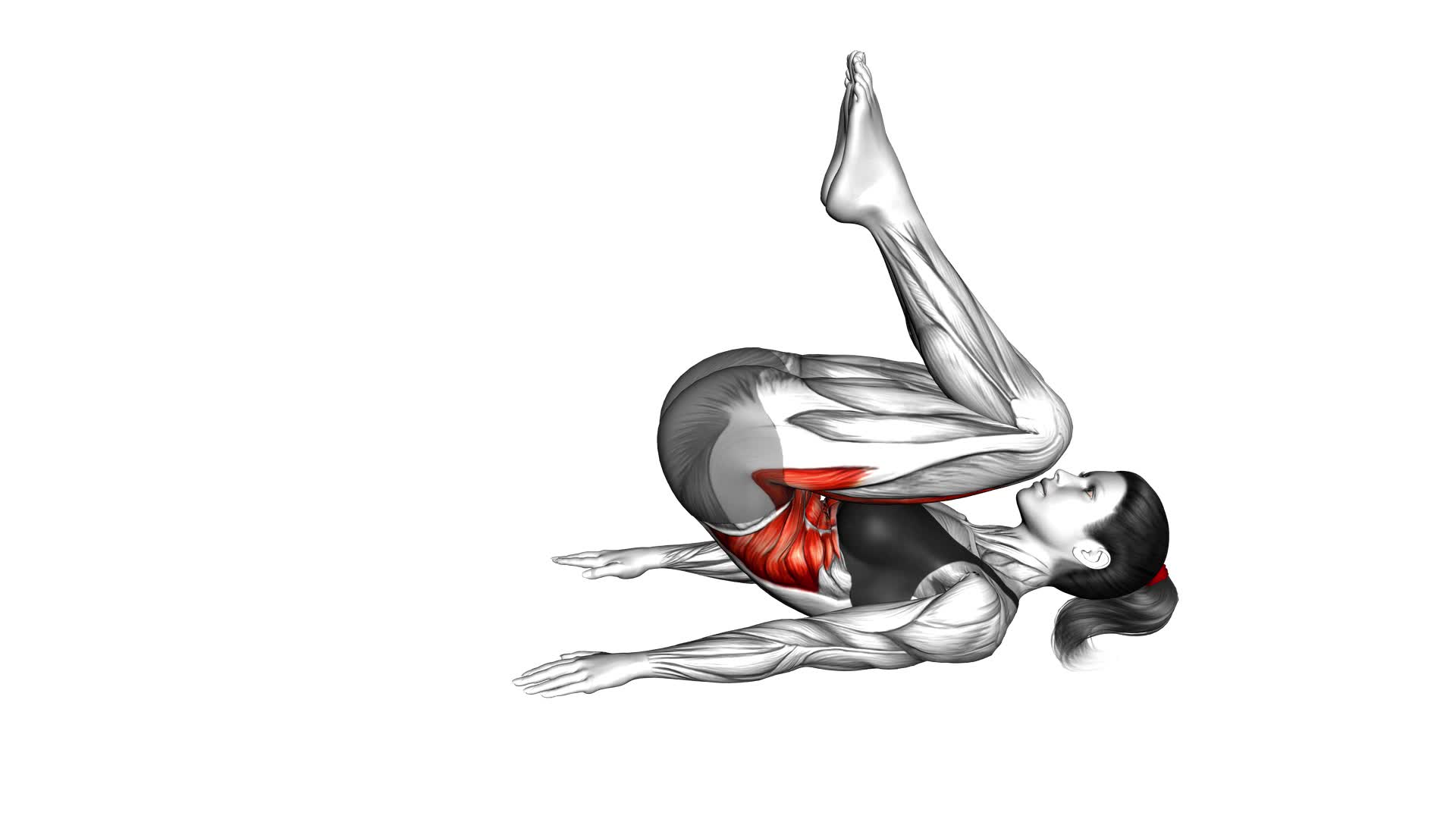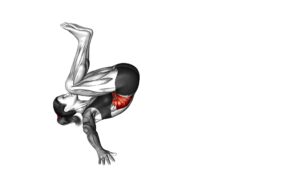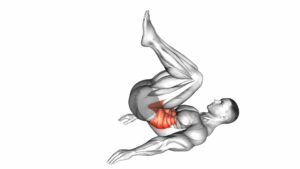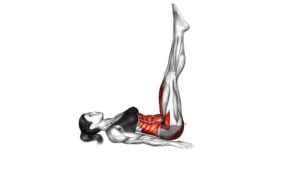Hip Raise (Bent Knee) (Version 2) (Female) – Video Exercise Guide & Tips

Get ready to tone your glutes and strengthen your core with the Hip Raise (Bent Knee) (Version 2). This exercise is perfect for females looking to enhance their lower body strength.
Watch This Exercise Video
In this video exercise guide, you'll learn the proper form and technique to maximize the effectiveness of this workout.
Whether you're a beginner or advanced fitness enthusiast, modifications are available to suit your fitness level.
Say goodbye to common mistakes and hello to a more sculpted physique!
Key Takeaways
- Hip Raise (Bent Knee) strengthens core muscles, lower abs, hip flexors, and glutes.
- It improves overall core stability, balance, posture, and reduces the risk of back pain and injuries.
- Minimal equipment is required, and modifications can be made using a resistance band or stability ball.
- Proper form and technique involve engaging glutes and hamstrings, maintaining a stable and controlled movement, and focusing on proper breathing.
Benefits of Hip Raise (Bent Knee) (Version 2)
One major benefit of performing the Hip Raise (Bent Knee) (Version 2) exercise is that it helps strengthen your core muscles. This exercise specifically targets your lower abs, hip flexors, and glutes. By engaging these muscles, you can improve your overall core stability and balance.
Additionally, the Hip Raise (Bent Knee) (Version 2) can also help improve your posture. When you have a strong core, it supports your spine and helps maintain proper alignment, reducing the risk of back pain and injuries.
To get the maximum benefits from the Hip Raise (Bent Knee) (Version 2) exercise, it's important to maintain proper form and technique. Start by lying flat on your back with your knees bent and feet flat on the floor. Keep your arms by your sides, palms facing down. Engage your core and lift your hips off the ground, creating a straight line from your knees to your shoulders. Hold the position for a few seconds before lowering your hips back down to the starting position.
Remember to breathe throughout the movement and avoid arching your back or pushing your hips too high. By following these guidelines, you can safely and effectively strengthen your core with the Hip Raise (Bent Knee) (Version 2) exercise.
Equipment Needed for Hip Raise (Bent Knee) (Version 2)
To perform the Hip Raise (Bent Knee) (Version 2) exercise, you'll need minimal equipment. This exercise primarily targets the glutes and hamstrings, helping to strengthen and tone these muscles. The good news is that you don't need any fancy or expensive equipment to perform this exercise. All you need is a comfortable and stable mat or exercise mat to lie on.
However, there are a few equipment options that you may consider to modify or intensify the hip raise (bent knee) (version 2) exercise. If you want to add an extra challenge and increase the resistance, you can use a resistance band. Simply place the band just above your knees and perform the hip raise as usual. The resistance band adds tension to the muscles, making the exercise more challenging.
Another modification option is to use a stability ball. By placing your feet on the ball instead of the ground, you can engage your core muscles even more. This variation requires more stability and balance, making it a great option for those looking for an extra challenge.
Proper Form and Technique for Hip Raise (Bent Knee) (Version 2)
To perform the Hip Raise (Bent Knee) (Version 2) exercise with proper form and technique, focus on engaging your glutes and hamstrings while maintaining a stable and controlled movement. Start by lying on your back with your knees bent and feet flat on the ground, hip-width apart. Place your arms by your sides, palms facing down. As you exhale, press through your heels and raise your hips off the floor, squeezing your glutes and hamstrings. Keep your core engaged and your back straight throughout the movement. Inhale as you lower your hips back down to the starting position.
Proper breathing technique is important during the Hip Raise (Bent Knee) (Version 2) exercise. Remember to exhale as you lift your hips and inhale as you lower them back down. This will help you maintain control and stability throughout the movement.
There are some common errors to watch out for when performing this exercise. Avoid arching your back or pushing your hips too high, as this can strain your lower back. Keep your movements slow and controlled, focusing on using your glutes and hamstrings to lift your hips, rather than relying on momentum.
Now that you understand the proper form and technique for the Hip Raise (Bent Knee) (Version 2) exercise, let's discuss modifications for different fitness levels in the next section.
Modifications for Different Fitness Levels
Now let's talk about modifications for different fitness levels.
Whether you're a beginner or more advanced, there are options to make the hip raise exercise work for you.
Beginner-friendly modifications can help you build strength and confidence, while advanced level adaptations can challenge your muscles even further.
Beginner-Friendly Modifications
Start by modifying the hip raise exercise to accommodate different fitness levels. Here are some beginner modifications and variations for different body types:
- Use a stability ball: Place the stability ball under your feet to provide extra support and stability during the exercise.
- Perform a bridge: Instead of raising your hips off the ground, start by lifting your glutes and lower back off the ground, keeping your feet flat on the floor.
- Use a resistance band: Place a resistance band around your thighs to add an extra challenge and engage your glutes even more.
- Lower the range of motion: If you find it difficult to lift your hips all the way up, start by lifting them just a few inches off the ground and gradually increase the range of motion.
- Use a step or bench: Place your feet on a step or bench to increase the difficulty and target your glutes and hamstrings.
Remember to listen to your body and choose modifications that suit your fitness level.
Advanced Level Adaptations
As you progress to advanced levels, you can further modify the hip raise exercise to challenge your fitness level and target different muscle groups.
To perform advanced level modifications for the hip raise (bent knee) (version 2), you can try adding resistance by placing a weight plate or barbell across your hips. This will increase the intensity of the exercise and provide an additional challenge for your glutes and hamstrings.
Another advanced variation is the single-leg hip raise, where you raise one leg off the ground while performing the exercise. This places more emphasis on the working leg and increases the difficulty level.
Additionally, you can incorporate stability equipment such as a stability ball or Bosu ball to further challenge your balance and core stability during the hip raise exercise.
These advanced level modifications and progressions will help you continue to improve and push your fitness limits.
Tailoring Workouts for All
To tailor workouts for all fitness levels, you can make modifications based on individual needs and abilities. Inclusivity in fitness is important, and by making adjustments, you can ensure that everyone can participate and benefit from the exercise. Here are some ways to tailor workouts for different fitness levels:
- Adjust the intensity or duration of the exercise based on the individual's fitness level.
- Provide alternative exercises or variations for those with physical limitations or injuries.
- Offer modifications to make the exercise easier or more challenging, depending on the person's abilities.
- Use equipment or props to assist or add resistance, as needed.
- Encourage individuals to listen to their bodies and make adjustments accordingly.
By tailoring workouts to accommodate different fitness levels, you create a more inclusive and supportive environment for everyone.
Now let's discuss some common mistakes to avoid during the hip raise (bent knee) (version 2).
Common Mistakes to Avoid During Hip Raise (Bent Knee) (Version 2)
To perform the hip raise (bent knee) (version 2) correctly, it's important to maintain proper spinal alignment and engage your core muscles. Avoid arching your back or allowing your lower back to sag during the exercise, as this can strain your spine.
Additionally, make sure to actively contract your abdominal muscles to ensure that you're effectively targeting your core and glutes.
Proper Spinal Alignment
Maintain proper spinal alignment during the Hip Raise (Bent Knee) (Version 2) exercise to avoid common mistakes. To ensure you maintain the correct alignment, follow these tips:
- Keep your tailbone in a neutral position: Avoid tucking your tailbone under or sticking it out, as this can strain your lower back.
- Engage your glutes: Activate your glute muscles to support your spine and prevent excessive arching or rounding of the lower back.
- Avoid overarching your lower back: Maintain a slight natural curve in your lower back throughout the movement.
- Keep your shoulders relaxed: Avoid shrugging or tensing your shoulders, as this can contribute to poor spinal alignment.
- Maintain a stable core: Engage your core muscles to provide stability and support for your spine during the exercise.
Engaging Core Muscles
Engage your core muscles to maintain stability and prevent common mistakes during the Hip Raise (Bent Knee) (Version 2) exercise. Core engagement is crucial for proper form and maximizing the benefits of this exercise. By activating your core, you stabilize your spine and pelvis, allowing for a controlled movement and minimizing the risk of injury.
To engage your core, focus on pulling your belly button towards your spine. This action activates the deep abdominal muscles, including the transverse abdominis, which acts as a natural corset for your spine. Additionally, squeeze your glutes and imagine a string pulling your belly button towards the ceiling, creating a straight line from your shoulders to your knees.
By incorporating core strengthening exercises into your routine, such as planks and deadbugs, you can improve your core stability and enhance your performance in the Hip Raise (Bent Knee) (Version 2) exercise.
Tips for Maximizing the Effectiveness of Hip Raise (Bent Knee) (Version 2)
To maximize the effectiveness of the Hip Raise (Bent Knee) (Version 2), focus on squeezing your glutes at the top of the movement. This will help engage your glute muscles and ensure that you're getting the most out of this exercise.
Here are some tips to further enhance the effectiveness of the hip raise:
- Maintain proper form: Keep your feet flat on the ground and your knees bent at a 90-degree angle. This will ensure that you're targeting the correct muscles and not putting unnecessary strain on your lower back.
- Control the movement: Slowly raise your hips off the ground and then lower them back down in a controlled manner. This will help to engage your glutes throughout the entire range of motion.
- Increase resistance: To make the exercise more challenging, you can place a weight or resistance band across your hips. This will add resistance and help to further strengthen your glutes.
- Try different variations: There are various ways to perform the hip raise, such as single leg hip raise or hip raise with leg extension. Experiment with different variations to target different areas of your glutes.
- Incorporate it into your routine: To maximize results, try to include the hip raise in your regular workout routine at least two to three times a week.
Frequently Asked Questions
How Many Calories Can You Burn Doing the Hip Raise (Bent Knee) (Version 2)?
The hip raise (bent knee) (version 2) is a great exercise for targeting your glutes and hamstrings.
While the number of calories burned during this exercise can vary depending on factors like intensity and duration, it can be an effective way to burn calories and tone your lower body.
Incorporating hip raise (bent knee) (version 2) into a full body workout routine can help you achieve overall strength and muscle definition.
Can the Hip Raise (Bent Knee) (Version 2) Help in Reducing Belly Fat?
The hip raise (bent knee) (version 2) can be effective in targeting your abdominal muscles. It helps engage your core and strengthen the muscles in your lower abdomen.
While it can contribute to overall fat loss, it's important to note that spot reduction isn't possible. To reduce belly fat, it's recommended to combine the hip raise with a balanced diet and regular cardio exercises.
Can the Hip Raise (Bent Knee) (Version 2) Be Done by People With Lower Back Pain?
Yes, the hip raise (bent knee) (version 2) can be modified for people with lower back pain. If you experience discomfort, there are alternative exercises you can try.
Consult with a fitness professional who can guide you on hip raise modifications that will be safe for your lower back. Remember to listen to your body and prioritize your health and comfort during your workouts.
How Often Should the Hip Raise (Bent Knee) (Version 2) Be Performed to See Results?
To see results from the hip raise variations, including the bent knee version 2, you should perform them regularly. Consistency is key! Aim to do this exercise at least 2-3 times a week, allowing for rest days in between.
By incorporating hip raise variations into your routine, you can target and strengthen your glutes, hamstrings, and core. These exercises can also help improve your hip mobility and stability.
Keep up the good work!
Can the Hip Raise (Bent Knee) (Version 2) Help in Improving Posture?
To improve your posture, the hip raise (bent knee) (version 2) is a great exercise.
By incorporating this move into your routine, you can strengthen your core muscles and improve balance.
This exercise targets the muscles in your hips, glutes, and lower back, which are essential for maintaining proper posture.
Regularly performing the hip raise (bent knee) (version 2) can help you stand taller and with better alignment, leading to improved posture overall.
Conclusion
In conclusion, the hip raise (bent knee) (version 2) is a highly effective exercise for targeting the muscles of the hips and glutes. It requires minimal equipment and can be modified to suit different fitness levels.
By maintaining proper form and avoiding common mistakes, individuals can maximize the effectiveness of this exercise.
Incorporating hip raise (bent knee) (version 2) into a regular workout routine can help improve strength, stability, and overall lower body function.

Author
Years ago, the spark of my life’s passion ignited in my mind the moment I stepped into the local gym for the first time. The inaugural bead of perspiration, the initial endeavor, the very first surge of endorphins, and a sense of pride that washed over me post-workout marked the beginning of my deep-seated interest in strength sports, fitness, and sports nutrition. This very curiosity blossomed rapidly into a profound fascination, propelling me to earn a Master’s degree in Physical Education from the Academy of Physical Education in Krakow, followed by a Sports Manager diploma from the Jagiellonian University. My journey of growth led me to gain more specialized qualifications, such as being a certified personal trainer with a focus on sports dietetics, a lifeguard, and an instructor for wellness and corrective gymnastics. Theoretical knowledge paired seamlessly with practical experience, reinforcing my belief that the transformation of individuals under my guidance was also a reflection of my personal growth. This belief holds true even today. Each day, I strive to push the boundaries and explore new realms. These realms gently elevate me to greater heights. The unique combination of passion for my field and the continuous quest for growth fuels my drive to break new ground.







